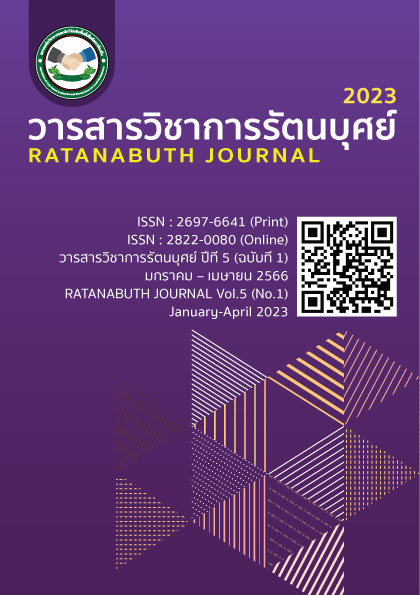The Principle of Aruakkhasampadha Dhamma for the Existence and Development to the Community Traditional of Northeastern Lower Region The Principle of Aruakkhasampadha Dhamma for the Existence and Development to the Community Traditional of Northeastern Lower Region
Main Article Content
Abstract
The purpose of this research was to study the creation and development of innovative media for promoting the Bun Bang Fai tradition, preserving the traditional values of the Thoomka lantern of Yasothon Province, and strengthening the traditional values of the garlands made with paddy rice for cultural tourism. The research uses the dharma principle of protecting and promoting the development of community traditions in the lower Isan region. It is a mixed research project consisting of three sub-projects, which aim to apply the research findings to teaching and learning, as well as integrating them with the local economic, social, and cultural environment. The research findings are as follows:
- Promoting and building cooperation among communities, educational institutions, government agencies, and religious institutions is a critical factor in continuing the good traditions. The creation of innovative media related to the rocket festival should focus on three aspects: (1) integrating the history of the rocket festival with the current situation in animation media, (2) promoting eco-tourism that connects the ASEAN community through content in animation media, and (3) presenting the history of the Bun Bang Fai tradition in an accessible and easily understandable animated medium.
- The community has the knowledge to organize the Thoomka lantern properly because they are the origin of the tradition. However, there are still some activities that are inconsistent, which are considered recreations of traditional events. Competition for meaning in appearance always occurs among various ethnic groups. The continuation and creation of the thoomka lantern in Yasothon Province is the continuation of beliefs and veneration expressed in the form of Buddhism.
3. The guidelines for promoting the culture and tradition of the paddy rice parade are as follows: (1) Religious leaders must create good awareness of cultural traditions to make them more outstanding. (2) Ceremonial leaders must be good role models in continuing the culture and traditions in the community. (3) Local government organizations and educational institutions in the community should be ready to support activities and traditions.
Article Details

This work is licensed under a Creative Commons Attribution-NonCommercial-NoDerivatives 4.0 International License.
References
กาญจนา คำผา. (2561). แนวทางการสืบทอดประเพณีฮีตสิบสองเพื่อการเสริมสร้างความเข้มแข็งของชุมชน. คณะศึกษาศาสตร์ มหาวิทยาลัยศิลปากร.
กองบริหารงานวิจัยและประกันคุณภาพการศึกษา. (2559). Thailand 4.0 โมเดลขับเคลื่อนประเทศไทยสู่ความมั่งคั่ง มั่นคงและยั่งยืน. กรุงเทพฯ: กองบริหารงานวิจัยและประกันคุณภาพการศึกษา.
ชนาวี ดลรุ้ง และคณะ. (2560). การสืบทอดมรดกทางวัฒนธรรมบุญสงกรานต์เพื่อพัฒนาการศึกษาตามแนวชายแดนไทย-กัมพูชา. วารสารชุมชนวิจัย, 11(3):95-109.
เทพศักดิ์ บุณยรัตพันธุ์. (2550). เอกสารการเรียนรู้การทำวิจัยด้วยตนเอง. (พิมพ์ครั้งที่ 2). นนทบุรี: มหาวิทยาลัยสุโขทัยธรรมาธิราช.
ประเพณีสยาม. (2562). ประเพณีไทย. สืบค้นเมื่อวันที่ 24 ธันวาคม พ.ศ. 2564 จาก http://siamtradition.blogspot.
สุดชีวัน นันทวัน ณ อยุธยา. (2558). การจัดการการท่องเที่ยวเชิงวัฒนธรรมโดยชุมชนเป็นศูนย์กลาง.รายงานการศึกษาอิสระปริญญาศิลปศาสตรมหาบัณฑิต สาขาวิชาเศรษฐศาสตร์การเมือง,บัณฑิตวิทยาลัย, มหาวิทยาลัยเชียงใหม่.
สำนักงานพัฒนาวิทยาศาสตร์และเทคโนโลยีแห่งชาติ (สวทช).(2542).นวัตกรรมในภาคบริการ นวัตกรรม: กุญแจสู่ความสำเร็จของประเทศไทยในศตวรรษที่ 21. กรุงเทพฯ:สำนักงานพัฒนาวิทยาศาสตร์และเทคโนโลยีแห่งชาติ.
บจก. ปิยวัฒนา. (2564). Snowball Sampling Technique: การเรียนรู้และเข้าถึงชุมชนด้วยการอ้างอิงต่อเนื่องปากต่อปากในวิจัยแบบ PAR. สืบค้นเมื่อวันที่ 24 ธันวาคม พ.ศ. 2564 จาก: https://www.gotoknow.org/posts/428764
Enable survey. (2564). การสุ่มตัวอย่าง (Sampling). สืบค้นเมื่อวันที่ 25 ธันวาคม พ.ศ. 2564,จาก: https://www.enablesurvey.com/article-detail/5e098336-686a-4fbd-88b1-cc80636f5d80/sampling


